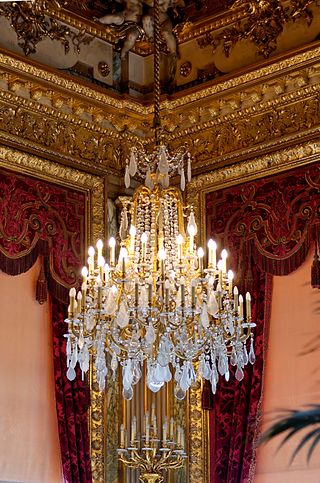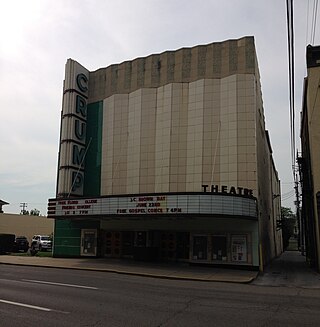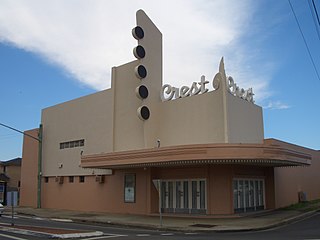
A chandelier ( is an ornamental light fixture with multiple lights, typically with spreading branched supports, designed to hang down from the ceiling. Chandeliers are often ornate, and they were originally designed to hold candles, but now incandescent light bulbs are commonly used, and fluorescent lamps and LEDs may also be used in some modern designs.

The Fox Theatre is a performing arts center located at 2211 Woodward Avenue in Downtown Detroit, Michigan, near the Grand Circus Park Historic District. Opened in 1928 as a flagship movie palace in the Fox Theatres chain, it was at over 5,000 seats the largest theater in the city. Designed by theater architect C. Howard Crane, it was listed on the National Register of Historic Places in 1985.

The Stanley Theater at Kennedy Boulevard and Pavonia Avenue is near Journal Square in Jersey City, New Jersey.
The Blue Mouse Theatre title was used for several historic vaudeville and movie venues opened by John Hamrick in the Pacific Northwest of the United States. The name may have been inspired by a lounge in Paris. Hamrick is said to have used the colored rodential title for his first theatre in each city.

An awning or overhang is a secondary covering attached to the exterior wall of a building. It is typically composed of canvas woven of acrylic, cotton or polyester yarn, or vinyl laminated to polyester fabric that is stretched tightly over a light structure of aluminium, iron or steel, possibly wood or transparent material. The configuration of this structure is something of a truss, space frame or planar frame. Awnings are also often constructed of aluminium understructure with aluminium sheeting. These aluminium awnings are often used when a fabric awning is not a practical application where snow load as well as wind loads may be a factor.

The Chicago Theatre, originally known as the Balaban and Katz Chicago Theatre, is a landmark theater located on North State Street in the Loop area of Chicago, Illinois. Built in 1921, the Chicago Theatre was the flagship for the Balaban and Katz (B&K) group of theaters run by A. J. Balaban, his brother Barney Balaban and partner Sam Katz. Along with the other B&K theaters, from 1925 to 1945 the Chicago Theatre was a dominant movie theater enterprise. Currently, Madison Square Garden, Inc. owns and operates the Chicago Theatre as a 3600 seat performing arts venue for stage plays, magic shows, comedy, speeches, sporting events and popular music concerts.

Saenger Theatre is an atmospheric theatre in downtown New Orleans, Louisiana, which is on the National Register of Historic Places. Once the flagship of Julian and Abe Saenger's theatre empire, today it is one of only a handful of Saenger movie palaces that remain.

A revival of the art and craft of stained-glass window manufacture took place in early 19th-century Britain, beginning with an armorial window created by Thomas Willement in 1811–12. The revival led to stained-glass windows becoming such a common and popular form of coloured pictorial representation that many thousands of people, most of whom would never commission or purchase a painting, contributed to the commission and purchase of stained-glass windows for their parish church.

Proctor's Theatre is a theatre and former vaudeville house located in Schenectady, New York, United States. Many famous artists have performed there, including Mariah Carey, Britney Spears, Hal Holbrook, Ted Wiles, and George Burns, as well as many others. It has one of the largest movie screens in the Northeast.

The Rivoli Theatre in South Fallsburg, New York, United States is located at the intersection of NY 42 and Laurel Avenue. It was built in 1923, renovated in the late 1930s and remains almost intact from that period.

The State Theatre is a historic theatre in Minneapolis, Minnesota, USA. It is one of four restored theatres in the Hennepin Theatre District.

The Mississippi Lofts and Adler Theatre is an apartment building and theater complex located in downtown Davenport, Iowa, United States. It is individually listed on the National Register of Historic Places by its original name, the Hotel Mississippi and RKO Orpheum Theater. The Hotel Mississippi was listed on the Davenport Register of Historic Properties in 2005. In 2020 the complex was included as a contributing property in the Davenport Downtown Commercial Historic District.

The Crump Theatre is located in downtown Columbus, Indiana, at 425 Third Street, is part of the Columbus Historic District, which is listed on the National Register of Historic Places. The theatre is owned by the Columbus Capital Foundation and periodically used as an event space for a variety of acts, including musicians, comedians, and paranormal investigators.

The Capitol Theater was a 700-seat theater in Burlington, Iowa. Opened in 1937, with the first showing being Mark Twain's classic The Prince and the Pauper. The theater was both a movie theater and an auditorium used for performances. The theater closed in March 1977, the final showing was the Stephen King horror classic Carrie.

The Eureka Theater is an Art Moderne–style cinema built in 1939 in Eureka, California. The movie theater was initially proposed in 1937 as part of a larger development that would include a five-story, 162-room hotel, which was soon scaled back to the theater with flanking commercial spaces. Built by theater magnate George M. Mann, the theater was designed by noted San Francisco designer William B. David, who had once worked in the Metro-Goldwyn-Mayer Art Department in the mid-1930s. The Eureka Theater was considered an ultra-modern movie theater when constructed in 1939 and was an expression of optimism and confidence in Eureka and Humboldt County, California as they pulled out of the Depression. The Eureka Theater ceased showing regularly scheduled movies on August 1, 1996. The theater is currently undergoing restoration, and is available for rent as a performance or event venue.

Pavement lights (UK), vault lights (US), floor lights, or sidewalk prisms are flat-topped walk-on skylights, usually set into pavement (sidewalks) or floors to let sunlight into the space below. They often use anidolic lighting prisms to throw the light sideways under the building. They were developed in the 19th century, but declined in popularity with the advent of cheap electric lighting in the early 20th. Older cities and smaller centers around the world have, or once had, pavement lights. In the early 21st century, such lights are approximately a century old, although lights are being installed in some new construction.

Prism lighting is the use of prisms to improve the distribution of light in a space. It is usually used to distribute daylight, and is a form of anidolic lighting.

Between 1900 and 1913, Hector Guimard was responsible for the first generation of entrances to the underground stations of the Paris Métro. His Art Nouveau designs in cast iron and glass dating mostly to 1900, and the associated lettering that he also designed, created what became known as the Métro style and popularized Art Nouveau. However, arbiters of style were scandalized and the public was also less enamored of his more elaborate entrances. In 1904 his design for the Opéra station at Place de l'Opéra was rejected and his association with the Métro ended; many of his station entrances have been demolished, including all three of the pavilion type. Those that remain are now all protected historical monuments, one has been reconstituted, and some originals and replicas also survive outside France.

Crest Theatre is a heritage-listed former cinema and ballroom and now community centre at 157 Blaxcell Street, Granville, City of Parramatta, New South Wales, Australia. It was designed by Cowper and Murphy and Associates and built in 1948 by A. W. Edwards Pty Ltd. It is also known as Hoyts Crest Theatre. Following its purchase by the Australian Blouza Association, it has been referred to as Blouza Hall. It was added to the New South Wales State Heritage Register on 1 August 2003.




















